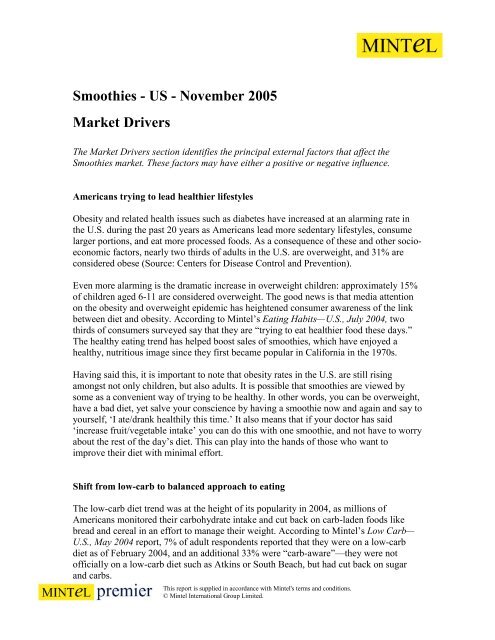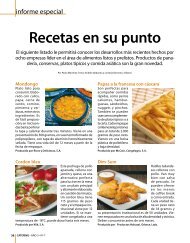Smoothies - US - November 2005 Executive ... - Catering.com.co
Smoothies - US - November 2005 Executive ... - Catering.com.co
Smoothies - US - November 2005 Executive ... - Catering.com.co
Create successful ePaper yourself
Turn your PDF publications into a flip-book with our unique Google optimized e-Paper software.
<strong>Smoothies</strong> - <strong>US</strong> - <strong>November</strong> <strong>2005</strong>Market DriversThe Market Drivers section identifies the principal external factors that affect the<strong>Smoothies</strong> market. These factors may have either a positive or negative influence.Americans trying to lead healthier lifestylesObesity and related health issues such as diabetes have increased at an alarming rate inthe U.S. during the past 20 years as Americans lead more sedentary lifestyles, <strong>co</strong>nsumelarger portions, and eat more processed foods. As a <strong>co</strong>nsequence of these and other socioe<strong>co</strong>nomicfactors, nearly two thirds of adults in the U.S. are overweight, and 31% are<strong>co</strong>nsidered obese (Source: Centers for Disease Control and Prevention).Even more alarming is the dramatic increase in overweight children: approximately 15%of children aged 6-11 are <strong>co</strong>nsidered overweight. The good news is that media attentionon the obesity and overweight epidemic has heightened <strong>co</strong>nsumer awareness of the linkbetween diet and obesity. Ac<strong>co</strong>rding to Mintel’s Eating Habits—U.S., July 2004, twothirds of <strong>co</strong>nsumers surveyed say that they are “trying to eat healthier food these days.”The healthy eating trend has helped boost sales of smoothies, which have enjoyed ahealthy, nutritious image since they first became popular in California in the 1970s.Having said this, it is important to note that obesity rates in the U.S. are still risingamongst not only children, but also adults. It is possible that smoothies are viewed bysome as a <strong>co</strong>nvenient way of trying to be healthy. In other words, you can be overweight,have a bad diet, yet salve your <strong>co</strong>nscience by having a smoothie now and again and say toyourself, ‘I ate/drank healthily this time.’ It also means that if your doctor has said‘increase fruit/vegetable intake’ you can do this with one smoothie, and not have to worryabout the rest of the day’s diet. This can play into the hands of those who want toimprove their diet with minimal effort.Shift from low-carb to balanced approach to eatingThe low-carb diet trend was at the height of its popularity in 2004, as millions ofAmericans monitored their carbohydrate intake and cut back on carb-laden foods likebread and cereal in an effort to manage their weight. Ac<strong>co</strong>rding to Mintel’s Low Carb—U.S., May 2004 report, 7% of adult respondents reported that they were on a low-carbdiet as of February 2004, and an additional 33% were “carb-aware”—they were notofficially on a low-carb diet such as Atkins or South Beach, but had cut back on sugarand carbs.This report is supplied in ac<strong>co</strong>rdance with Mintel's terms and <strong>co</strong>nditions.© Mintel International Group Limited.
















